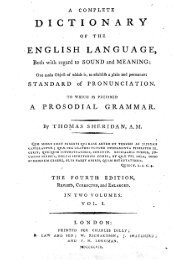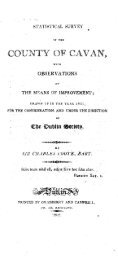just mentioned. The 15th and 16th century forms of many <strong>Cavan</strong>names, particularly parish titles, occur in the comprehensiveCalendar of Entries in the Papal Registers-Record Series, editedby W. H. Bliss ; but many of the names are disguised underLatinised spellings. I have consulted De Annatis Hibernia-Vol.I., Ulster-which is such a fruitful source of information onmediaeval parochial history. The Annals-Four Masters, LochCi., Clonmacnoise, etc.-as well as the Martyrologies are invaluablesourc.es for the authentic forms of early Gaelic naqes and areus11 ly decisive on questions of Gaelic etymology. The Registersof a' he mediaeval Archbishops of Armagh, covering the period1350 tc 1550, have occasional references to <strong>Cavan</strong> parishes, and theinformation obtainable from these precious manuscripts is alsoinvaluable especially as the parochial records for the same periodhave long since been irrecoverably lost.Discussion on the derivation and orthography of the placenamesoccurring in the Inquisition is not within the scope of thepresent investigation, and must be reserved for another occasion ;but if the original Gaelic names are to be accurately reconstructedand effectively restored there must be in every case an exhaustiveinquiry into all the original sources with a careful examinationof the earlier recorded forms. In these days of Gaelic restoration,and of de-anglicisation, it is essential that " modernisation "of Gaelic names should be discouraged ; neither should considerationsof grammatical accuracy be entirely disregarded. Inresearches of this nature a knowledge of local topography isabsolutely essential, especially in the location of placenames whichhave become obsolete. It may be necessary to remind teachersand students of history whose vnde mecum is O'Donovan's OrdnanceSurvey Letters that the great topographer is most unreliable indealing with Co. <strong>Cavan</strong>, and that many of the opinions advanced inthese Letters, written by him in 1836, were either entirely abandonedor drastically revised in his later and more mature writings.The views expressed in the Ordnance Survey Letters, whjch consistof a collection of rough notes and never intended for publicationin their present shape, must, therefore, always be acceptedwith reserve. Since O'Donovan's time a vast amount of historicalmaterials, which were quite inaccessible to him, have been madeavailable, and these throw new lig5t on many of the problemswhich to him were enigmas.A Survey of Co. <strong>Cavan</strong> taken at <strong>Cavan</strong> on September 6th) 1608,before Sir John Davies, Sir Edward Blany and William Parsons,Surveyor-General, is preserved in MS. Rawlinson A. 237, in theBodleian <strong>Library</strong>. Oxtord. In this manuscript, which has recentlybeen made accessible through the activities of the Irish ManuscriptsCommission, the particulars of the ecclesiastical lands inUlster are specified in detail, but considerations of space willnot allow of an e~tended discussion of these particulars in the
present paper. For purposes of comparison, however, I refer tothis source as Rawlinson MS.In mediaeval times the prevailing land denomination in Co.<strong>Cavan</strong> was the Poll, a unit which is mentioned frequently in thevarious Inqzrisifiom ; in Monaghan, Fermanagh, and elsewhere,it was called the Tate. The Poll was a unit of variable extentdepending on the nature and fertility of the soil ; hence it wasnot a fixed standard. In the Slate Papers of I610 the Poll isdefined as a unit of 25 acres. An earlier document of 1571 specifiesit as containing 30 acres arable with 20 acres pasture and mountain.In 1601 another authority sets it down as equivalent to60 acres arable. The unprofitable land, bog, wood, marsh,mountain, etc., was included with the arable land, but was definitelyexcluded for survey purposes. Different surveyors mightnot be unanimous in their opinions as to what constituted arable,or unarable, land. Everything would depend on the particularlocality. In Co. <strong>Cavan</strong>, according to Rawlinson MS., a Poll wasa parcel of 24 acres of arable land, and this may be accepted as itsdefinition in the 1609 Inquisition. In the King's Project for thePlantation of Ulster, reprinted in Harris' Hibernica (p, 117), aPoll is defined as 24 acres which agrees, substantially, with theestimate given in Rawlinson.In Co. Fermanagh the Tale contained 30 acres : in Co. Armaghit was reckoned as 100. The Poll, or Tate, was commonly knownas the Ballyboe-b~~te b6, i.e. cow land ; it was supposed to beable to support about twenty cows. The Ballyboe enters largelyinto our placenames. Sixteen Ballyboes comprised the Ballybetb~ i ~IACAI$ ~ e i.e. the townland of the victualler. The Ballybetwas the principal land unit within the Tuath or Tricha Ctd,the " Cantred " or "District." The Tm'cha Ce'd usually comprisedthirty Ballybets. According to the calculations of Dr.Reeves the extent of a Ballybet would have been about 1000acres (Reeves and Hardinge, Memoir on MSS. Maj$ed TownlandSurveys in Ireland, Trans. Royal Irish Academy, Vol. XXIV).But this estimate is based on the assumption that the measurementswere absolute, including both arable and unarable land.We know that this was not the case and that the unarable landwas not included for the purpose of survey, a fact which invalidatesthe conclusions of Dr. Reeves., Poll, Tate, and Ballyboe, are synonymous terms, but the acreagewas in every case dependent on local factors and varied with thecircumstances in the particular county. Owing to the exclusionof the unprofitable land from the surveys it is now scarcely possible,with any degree of certainty, to equate these ancient landmeasures with those of the present day. In certain districtswhere there was an absence of waste and unprofitable lands approximaterelations may be established. It is generally recognisedthat at the time of the Plantation of Ulster the variable
- Page 5 and 6: PAGEThe Cavan Inquisition of 1609 .
- Page 7: and the Report of this Inquisition,
- Page 11 and 12: But that the parishioners usually g
- Page 13 and 14: TEXT OF THE INQUISITION.Finding-tha
- Page 15 and 16: coataining 4 ballibetaghs, the pars
- Page 17 and 18: arony of Tolcha :* Killnelynagh,f 2
- Page 19 and 20: etaghs and 1 poll, the parsonage im
- Page 21 and 22: allibetaghs in said barony, are par
- Page 23 and 24: Eniskine*, 2 polls, 3s. 4d. ; Killa
- Page 25 and 26: a pottle of land, parcel of said pa
- Page 27 and 28: if the corbe or herenagh, or any of
- Page 29 and 30: the sacraments and perform other sa
- Page 31 and 32: analysis of the records of the Iris
- Page 33 and 34: VICE-SOVEREIGNS,The first mention o
- Page 35 and 36: It is more than possible that it wa
- Page 37 and 38: Ballard-7 freemen and 1 burgess. Li
- Page 39 and 40: Year : . Date Elected :1779 June 28
- Page 41 and 42: Year: Date Elected :1762 June 28th1
- Page 43 and 44: Year : Date Elected :1708 { Jme 28t
- Page 45 and 46: 400Sear : Date Elected : Date Sworn
- Page 47 and 48: .Year : Date Elected : Date Sworn :
- Page 49 and 50: Year : Date Elected :June 27thJune
- Page 51 and 52: Year : Date Elected :1741 May 14th1
- Page 53 and 54: Year : Date Elected : Date Sworn :
- Page 55 and 56: Year : Date Elected :Date Sworn :Na
- Page 57 and 58: Year : Date Elected : Date Sworn :
- Page 59 and 60:
\Year: Date Elected : ' Date Sworn:
- Page 61 and 62:
i 416Year : Date Elected :1708 { Ja
- Page 63 and 64:
418BOROUGH OF CAVAN.---LIST OF M'EM
- Page 65 and 66:
Year : Names of Freemen :1755 The H
- Page 67 and 68:
The burial was located on a project
- Page 69 and 70:
ourhood of the present town of Ball
- Page 71 and 72:
discovered in 1932 were, in part at
- Page 73 and 74:
of Journal ; E. J. Smyth, Hibernian
- Page 75 and 76:
paper, which is a lengthy one, is r
- Page 77 and 78:
and that infinite variety and beaut
- Page 79 and 80:
Dublin, carrying 48 passengers, in&
- Page 81 and 82:
VERY REV. MICHAEL J. FLYNN. Rector
- Page 83 and 84:
thousands of extracts from the Chan
- Page 85 and 86:
Preiffne antiquarian anb Bis'torica
- Page 87 and 88:
FARRELLY, T.M. .. ...FIGGIS, W.F. .





